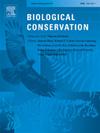探索塞尔维亚喀尔巴阡山脉的草原生物多样性热点:跨学科视角和保护意义
IF 4.9
1区 环境科学与生态学
Q1 BIODIVERSITY CONSERVATION
引用次数: 0
摘要
土地使用的变化导致近代欧洲农业景观的生物多样性减少。尽管如此,实行持续低投入耕作的地区仍然拥有欧洲大部分具有高自然价值的草原。塞尔维亚喀尔巴阡山脉就是这样一个相对未被发现的地区,拥有保存完好的宝贵生物文化遗产。通过整合植物学、生态学、遥感、历史和民族学的新型跨学科研究,我们探索了两个具有不同民族背景的村庄(Radenka 和 Suvi Do)。我们的主要目标是评估草原植物多样性,将其与应用的耕作方式联系起来,并强调跨学科研究在保护半自然草原方面的重要性。我们重点研究了随机选择的嵌套地块系列中出现的维管束植物、真菌和地衣,涵盖七个不同的空间尺度。与欧洲其他温带中湿性和中湿性草原相比,这两个村庄的半天然草原表现出显著的植物多样性。历史上农耕系统的重要组成部分,如干草草场春秋两季放牧的古老习俗,在这里依然得以保留。同样,根据传统节日确定的割草和放牧时间也继续得到遵守。然而,对过去 36 年管理强度的比较表明,由于严重的人口减少、牲畜数量下降以及从牛奶生产向肉类生产的转变,所有研究的地块都在逐渐废弃。我们主张鼓励传统的草原管理方法,以保持较高的植物多样性。我们的研究强调了跨学科研究的必要性,即结合社会科学来理解人类对半自然草地的影响,并结合遥感技术来评估管理方法及其强度的时间变化。本文章由计算机程序翻译,如有差异,请以英文原文为准。
Exploring a grassland biodiversity hotspot in the Serbian Carpathians: Interdisciplinary perspectives and conservation implications
Land-use changes resulted in a decline of biodiversity in recent European agricultural landscapes. Nevertheless, regions practicing sustained low-input farming continue to harbor most of Europe's high-nature-value grasslands. The Serbian Carpathians represent one such relatively undiscovered region, boasting a well-preserved valuable bio-cultural heritage. Through novel interdisciplinary research that integrates botany, ecology, remote sensing, history, and ethnology, we explored two villages (Radenka, Suvi Do) with different ethnic backgrounds. Our primary objectives were to assess grassland plant diversity, correlate it with applied farming practices, and highlight the importance of interdisciplinary research in conservation of semi-natural grasslands. We focused on vascular plants, bryophytes, and lichens that occur within randomly selected nested plot series, covering seven different spatial scales. The semi-natural grasslands in both villages exhibited remarkable plant diversity compared to other temperate meso-xeric and mesic grasslands in Europe. Integral parts of the historic farming system, such as the ancient practice of spring and autumn grazing of hay meadows, are still preserved there. Similarly, the timing of mowing and grazing based on traditional feasts continues to be observed. However, comparison of management intensity over the last 36 years indicates gradual abandonment in all studied parcels, due to severe depopulation, decline in livestock numbers, and a shift from milk to meat production. We advocate encouraging traditional grassland management practices to maintain high plant diversity. Our study underscores the need for interdisciplinary research, integrating social sciences to comprehend human influences on semi-natural grasslands, and remote sensing to assess temporal variations in management practices and their intensity.
求助全文
通过发布文献求助,成功后即可免费获取论文全文。
去求助
来源期刊

Biological Conservation
环境科学-环境科学
CiteScore
10.20
自引率
3.40%
发文量
295
审稿时长
61 days
期刊介绍:
Biological Conservation is an international leading journal in the discipline of conservation biology. The journal publishes articles spanning a diverse range of fields that contribute to the biological, sociological, and economic dimensions of conservation and natural resource management. The primary aim of Biological Conservation is the publication of high-quality papers that advance the science and practice of conservation, or which demonstrate the application of conservation principles for natural resource management and policy. Therefore it will be of interest to a broad international readership.
 求助内容:
求助内容: 应助结果提醒方式:
应助结果提醒方式:


